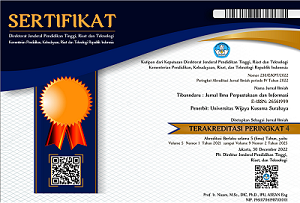Media Informasi Kesehatan untuk Pencegahan HIV/AIDS Yang Disukai Generasi Z: Upaya Penurunan Kasus HIV/AIDS di Kalangan Remaja di Indonesia
Abstract
Purpose Research. A good knowledge and sources of information of HIV/AIDS can decrease the risk of HIV/AIDS transmission in adolescents.  Therefore, it is not only the most effective media for adolescents be considered, but also what media is most preferred. This is important  because it will have an impact on the frequent use of the media,  so the goal of increasing knowledge and behavior change towards the prevention of HIV/AIDS transmission is expected to be achieved. Research Methods. This study was conducted using quantitative method. The population was 242 people with a stratified sampling sample of 71 students from a high school in Jakarta.  Respondents' understanding of information shown through videos about HIV/AIDS prevention and information about HIV/AIDS obtained from the KPAN internet site was explored through an online questionnaire using Google form. Analysis Data. Data processing was done with descriptive statistics using the SPSS version 22 application. Results and Discussions Respondents' perceptions showed that HIV/AIDS prevention information obtained from videos was clearer than information obtained from the KPAN website. Respondents preferred videos as a medium that provides information about HIV/AIDS, symptoms, modes of transmission, treatment, prevention, and its impact. Conclusion, Generation Z adolescents prefer video as a medium for HIV/AIDS prevention information. Information obtained from video also influences the respondents' perspective on HIV/AIDS. Video can be recommended as an information media in prevention and  reduction of HIV/AIDS  for adolescents.
Keywords : health information, HIV/AIDS, senior high school student, video, Z generation
Full Text:
FulltextReferences
DAFTAR PUSTAKA
Alonge, A. J., Kiai, W., & Ndati, N. (2017). Assessment of factors affecting social media use for HIV andAIDS communication among undergraduate students in South-Western Nigeria. Journal of Development and Communication Studies, 5(1), 56. https://doi.org/10.4314/jdcs.v5i1.4
Ambarwati, E. R., Rahmawati, I., & Mawarti, T. (2021). The use of audio visual promotion media towards the improvement of teenagers’ knowledge and attitude about hiv/aids. International Journal of Public Health Science, 10(3), 459–464. https://doi.org/10.11591/ijphs.v10i3.20838
Ashar, A., 2011. Media Pembelajaran, Jakarta: PT. Raja Grafindo
Azizah, L. N., & Istiqomah, I. N. (2020). Edukasi Pencegahan HIV/AIDS Menggunakan Media Audio Visual pada Siswa SMAN Yosowilangun Kabupaten Lumajang. Jurnal Peduli Masyarakat, 1(1), 1–6. https://doi.org/10.37287/jpm.v1i1.79
Bannor, R., Asare, A., Bawole, J. (2017). Effectiveness of social media for communicating health messages in Ghana. Health Education, 117(4), 342–371.
DataIndonesia.id
https://dataindonesia.id/digital/detail/remaja-paling-banyak-gunakan-internet-di-indonesia-pada-2022
Delver, B, et.al, 10 Ten Media Literacy Competencies
Edikpa, E. C., Okeke, F. C., Chigbu, B. C., Agu, P., Onu, A. E., Diara, C. F., Nwafor, B. N., & Nwankwor, P. (2019). School Management and Administrative Implications of Video Education Intervention for HIV/AIDS Awareness Among School Children. Global Journal of Health Science, 11(8), 17. https://doi.org/10.5539/gjhs.v11n8p17
Fauziah, M., & Rumaf, M. (2016). Intervention Using Social Media Facebook As Health Education Media in Increasing Adolescent’s Knowledge and Attitude on HIV/AIDS. The 2nd International Multidiciplinary Conference, 1(1), 652–660.
Haringi, S, Nani Yuniar, Nur Nashriana Jufri, 2016, Gambaran Perilaku Siswa SMA dalam Upaya Pencegahan HIV AIDS di Wilayah Kota Kendari Tahun 2016.
Hieftje, K., Fiellin, L. E., Pendergrass, T., & Duncan, L. R. (2016). Development of an HIV Prevention Videogame: Lessons Learned. International Journal of Serious Games, 3(2), 83–90. https://doi.org/10.17083/ijsg.v3i2.110
Katadata Media Network, 2020, Berapa Usia Mayoritas Pengguna Media Sosial di Indonesia?https://databoks.katadata.co.id/datapublish/2020/11/23/berapa-usia-mayoritas-pengguna-media-sosial-di-indonesia
Kementerian Kesehatan RI. (2019). Laporan Situasi Perkembangan HIV/AIDS & PIMS di Indonesia Januari-Juni 2019.
Komisi Penanggulangan AIDS. (2011). Pencegahan HIV. http://www.aidsindonesia.or.id/dasar-hiv-aids/pencegahan
Maloney, K. M., Bratcher, A., Wilkerson, R., & Sullivan, P. S. (2020). Electronic and other new media technology interventions for HIV care and prevention: a systematic review. Journal of the International AIDS Society, 23(1). https://doi.org/10.1002/jia2.25439
Martens, C. (2019). A MÃDIA E CAMPANHAS EDUCATIVAS SOBRE HIV/AIDS: RESPONSABILIDADE CORPORATIVA, ESTÉTICA E PODER. 13, 256–275.
Muntamah, U., & Ismiryam, F. F. (2018). Pengembangan Media Sosial sebagai New Media Informatif sebagai Upaya Peningkatan Pengetahuan Remaja tentang HIV-AID. 1(2), 62–72.
Natalia, I. M., Sianturi, S. R., & Susilo, W. H. (2021). Increasing Knowledge of HIV/AIDS in Adolescents using Video-Blogging. Media Keperawatan Indonesia, 4(1), 22–28. https://doi.org/10.26714/mki.4.1.2021.22-28
Nwaolikpe, O. N. (2018). Communicating HIV/AIDS to Adolescents in South-West Nigeria: The Case of MTV Shuga series. IOSR Journal of Humanitities and Social Science, 23(1), 36–45. https://doi.org/10.9790/0837-2301013645
Obare, F., Birungi, H., Deacon, B., & Burnet, R. (2013). Effectiveness of using comic books to communicate HIV and AIDS messages to in-school youth: Insights from a pilot intervention study in Nairobi, Kenya. Etude de La Population Africaine, 27(2), 203–215. https://doi.org/10.11564/27-2-441
Putra, YS, 2016, Theoritical Review: Teori Perbedaan Generasi, Among Makarti Jurnal Economics & Business vol 9(2) https://jurnal.stieama.ac.id/index.php/ama/article/view/142
Qiu, M., & Wu, Y. (2022). Knowledge and Perceptions of Chinese Female College Students Towards HIV/AIDS: A Qualitative Analysis. International Journal of Women’s Health, 14(August), 1267–1280. https://doi.org/10.2147/IJWH.S374976
Ren, J., Li, M., Luo, Y., Zheng, Y., Tang, J., Wang, Y., & Chen, Y. (2022). Sunset Without AIDS: protocol for a randomized controlled trial of a brief video-based intervention to improve the ability of AIDS prevention in elderly men. Trials, 23(1), 1–16. https://doi.org/10.1186/s13063-022-06069-3
Suharti, S., & Daryono, D. (2020). Efektifitas Video Berdialek Bahasa Jambi untuk Meningkatkan Pengetahuan tentang Penyakit HIV/AIDS pada Remaja di SMAN 8 Kabupaten Muaro Jambi. Jurnal Ilmiah Universitas Batanghari Jambi, 20(2), 418–423. https://doi.org/10.33087/jiubj.v20i2.953
Tanof, Y. H. D., Manurung, I. F. E., & Purnawan, S. (2021). Effectiveness of Educational Video Media to Increased Knowledge and Attitude in Knowing the Dangers of HIV/AIDS Disease In Adolescent Students Junior High School 2 Kupang City In 2020. Journal of Health and Behavioral Science, 3(1), 1–12. https://doi.org/10.35508/jhbs.v3i1.3016
Wisudawati, S. N., Shaluhiyah, Z., & Jati, S. P. (2021). Characteristics Of Youtube Content Related To The Prevention of HIV/AIDS Transmission. The International Journal of Health, Education and Social, 4(4), 1–9.
World Health Organization, 2016, http://search.who.int/search?q=HIV+AIDS&ie=utf8&site=who&client=_en_r&proxystylesheet=_en_r&output=xml_no_dtd&oe=utf8&getfields=doctype
DOI: http://dx.doi.org/10.30742/tb.v7i1.2824
Refbacks
- There are currently no refbacks.

This work is licensed under a Creative Commons Attribution-NonCommercial 4.0 International License.
Tibanndaru: Jurnal Ilmu Perpustakaan dan Informasi is indexing by:
Â
Reference Management Tools
 
![]()


.png)






